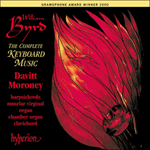
Welcome to Hyperion Records, a British classical label devoted to presenting high-quality recordings of music of all styles and from all periods from the twelfth century to the twenty-first.
Hyperion offers both CDs, and downloads in a number of formats. The site is also available in several languages.
Please use the dropdown buttons to set your preferred options, or use the checkbox to accept the defaults.

| Davitt Moroney (muselar)» More |
There is a long tradition of musical ‘battle pieces’, from Clément Janequin (La Guerre or La Bataille, commemorating the battle of Marignano, 1515) onwards. Other notable works include Bull’s keyboard work A Battle and no Battle. Quotations from well-known ‘battle tunes’ also occur in two lute works by Dowland, the Battle Galliard (also known as The King of Denmark’s Galliard), and Mr Langtons Galliard.
The two pieces associated with Byrd’s The Battell, The Marche before the Battell and The Galliard for the victorie, clearly form a separate pair of works in a different key (G major), and fine pieces they are. It is worth listening to them independently, omitting The Battell, just to appreciate their richness of invention. The March is called The Earle of Oxfords Marche in the FVB (No 259), although the Earl of Oxford took no part in the Irish campaign. Morley includes the tune in his compilation of Consort Lessons (1599), under the title My Lord of Oxenfords Maske. Dowland also drew on it for his somewhat different Lord Strangs March.
The nine sections of Byrd’s work are as follows: (a) the Souldier’s sommons; (b) the Marche of footemen; (c) the Marche of horsemen; (d) the Trumpetts; (e) the Irishe marche; (f) the Bagpipe and the drone; (g) the Flute & the droome; (h) the Marche to the fighte ; tantara, tantara ; the battells be ioyned; (i) the Retreat.
from notes by Davitt Moroney © 1999
Il y a une longue tradition de pièces musicales qui décrivent des batailles, depuis Clément Janequin (La Guerre ou La Bataille, commémorant la bataille de Marignan, 1515). Une autre œuvre fameuse de ce genre est de Bull, A Battle and no Battle. Des citations de “mélodies de bataille” (“battle tunes”) se trouvent également dans deux œuvres pour luth de Dowland, la Battle Galliard (connue aussi sous le nom de The King of Denmark’s Galliard), et Mr Langtons Galliard.
Les deux pièces supplémentaires, qui entourent The Battell, que sont The Marche before the Battell et The Galliard for the victorie sont visiblement des compositions autonomes, ayant une autre tonalité (sol majeur). Elles sont particulièrement réussies. Cela vaut la peine de les écouter indépendamment, en omettant The Battell, afin de mieux apprécier la richesse de leur invention. La marche est connue sous le nom The Earle of Oxfords Marche dans le FVB (n° 259), bien que le comte d’Oxford n’ait pris aucune part à la Campagne irlandaise. Morley publie la mélodie dans ses Consort Lessons (1599), sous le titre My Lord of Oxenfords Maske. Dowland l’utilise également pour Lord Strangs March.
Les neuf sections de The Battell sont : (a) l’appel des soldats ; (b) la marche de l’infanterie ; (c) la marche de la cavalerie ; (d) les trompettes ; (e) la marche irlandaise ; (f) la cornemuse et le bourdon ; (g) la flûte et le tambour ; (h) la marche vers la bataille ; tantara, tantara ; la bataille s’est engagée ; (i) la retraite.
extrait des notes rédigées par Davitt Moroney © 1999
 Byrd: The Complete Keyboard Music Byrd: The Complete Keyboard MusicAn authentic complete survey of this music. This unique recording won the Gramophone’s Early Music Award in 2000.» More |

